SOCIAL MEDIA MANAGEMENT
1. What is social media management?
The term “social media” refers to a number of technologies that make it easier for their users to share thoughts and information. All digital platforms and online communication technologies allow people and businesses to produce, distribute, and engage with content as well as connect with others in a virtual social environment.
Maybe the easiest approach to comprehend the word more clearly is to break it down into simpler terms rather than define it using a bunch of dull jargon that would probably only make things more complicated. Let’s first examine each word in isolation.
The term “social” refers to connecting with others and exchanging and receiving information from them. While TV, radio, and newspapers are examples of more conventional types of media, the term “media” refers to a tool of communication, such as the internet.
We can put together the following basic definition from these two distinct terms: Social media are web-based communication platforms that let users share and consume information with one another.
Social media management is the ongoing process of managing your online presence on social media platforms. It involves creating, publishing, and analyzing content you post on social media platforms like Facebook, Instagram, and Twitter, as well as engaging with users on those platforms. Effective social media management may help you reach a wider audience, increase income and sales, and eventually build your business.
2. Social media management benifits
One of the finest ways to engage with your audience is through social media, and its large user base is one of its biggest advantages for businesses. Almost 4.89 billion individuals use social media platforms worldwide to read news, make purchases, and stay in touch with friends and family. Correct use of your social media platforms can help you achieve the following advantages:
Social media management has several advantages for people, companies, and groups trying to accomplish a variety of objectives and build a strong online presence. Here are a few main benefits:
-
Increase Brand Awareness: Maintaining an active and consistent social media presence increases brand awareness. It gives you the opportunity to connect with a larger audience and introduce your business to people who would not have otherwise heard of it.
-
Improve Customer Engagement: Social media sites give you a direct line of communication with your followers. Interacting with posts, messages, and comments encourages followers to be devoted to one another and to the community.
-
Enhance Customer Service: Real-time problem-solving and customer service are made possible through social media. You may quickly respond to questions, concerns, and comments from customers, increasing their level of happiness.
-
Cost-Effective Marketing: Social media networks provide alternatives for both sponsored and organic (unpaid) advertising. This adaptability enables companies to successfully reach their target market even on a tight budget.
-
Targeted Advertising: Social networking sites offer advanced options for targeting based on behaviours, interests, and demographics. Businesses can reach the most relevant audiences with their messaging thanks to this accuracy.
-
Increase Website Traffic: Using social media to spread links to your website can improve traffic and even boost conversions, like purchases or newsletter sign-ups.
-
Lead Generation: Social media, especially sites like Facebook and LinkedIn where lead generation campaigns can be conducted, can be a useful tool for producing leads.
-
Brand Loyalty: Social media interaction and engagement with your audience can increase trust and brand loyalty. Clients who identify with your brand are more inclined to buy from you again.
-
Measurable Results: You can track the effectiveness of your campaigns with the use of analytics and insights provided by most social media networks. Important metrics that can be measured are clicks, conversions, reach, and engagement.
3. Social Media Management Goals
Setting clear and measurable goals is a fundamental step in social media management. It provides direction, helps evaluate the success of your social media efforts, and ensures that your activities align with your overall business or personal objectives. Here’s a closer look at the importance of setting such goals and some common examples of social media goals:
Examples of Common Social Media Goals:
3. Social Media Platforms: How To choose the Right One
Social media may assist you in achieving all of your goals, including connecting with professionals, enhancing customer service, adding knowledge about a trendy topic, and connecting with users’ creative and aspirational sides through images and videos.
If your new firm is just getting started, you are aware that acquiring consumers is the only method to generate sales and orders. You also understand that a “make and wait” strategy is ineffective and will ultimately lead to the downfall of your company.
Furthermore, it is even more crucial to begin marketing on social media now that we have the ability to interact with both present and potential customers there. You may be thinking, nevertheless, how to pick the appropriate social networking platforms. In this blog, we’ve covered a number of crucial considerations for selecting the best social media platform as well as in-depth analyses of each one.
Here’s how to select the most suitable platforms for your specific audience and goals:
-
Know The Audience: Recognise your target audience first. They are who? What are their geography, gender, and age demographics? What behaviours and interests do they have?
Determine which social networking sites they like to use. Certain demographics and age groups tend to favour particular platforms over others. For example, the user base of Facebook is more diversified than that of TikTok, which is more popular with younger users.
-
Understand Your Goals: Clearly state your objectives on social media. Are you trying to raise sales, create leads, improve website traffic, or raise brand awareness? Your choice of platform will be influenced by your objectives.
-
Research Social Media Platforms: Examine the qualities and attributes of various social media networks. Recognise their operating principles, the most popular content categories, and the user demographics.
Think about the benefits of the platform. For instance, Twitter is well-known for breaking news and real-time updates, Instagram is focused on images, and LinkedIn is used for professional networking.
-
Competitor Analysis: Examine how your rivals are using social media. Which platforms do they utilise, and what level of success do they achieve there?
Find the holes in the plans of your rivals and evaluate whether those platforms present a chance for your company.
-
Resource Availability: Take into account the time, money, and staff that are available for managing social media. Depending on the platform, varying amounts of money may need to be spent on advertising and content production.
-
Platform Suitability for Content: Evaluate the kind of material you intend to produce. Certain content formats work better on certain systems than others. Longer-form material is more suited for sites like YouTube and LinkedIn, whereas visual content is more effective on Instagram and Pinterest.
-
Cross-Promotion Opportunities:
Examine the possibilities for joint advertising. Certain platforms could have capabilities for sharing or integration, enabling you to take advantage of your presence on several platforms.
-
Test and Analyze: Expand on the basis of performance, starting with a limited number of platforms. Analyse important metrics on every platform, including conversions, reach, and engagement.
Focus your efforts on the most productive platforms by reviewing your social media analytics on a regular basis and making any adjustments to your plan.
-
Stay Informed: User preferences and social media trends evolve over time. Keep up with platform developments and behavioural shifts among users. Modify your plan of action accordingly.
-
Experiment and Iterate: Try out different tactics and platforms without fear. Because social media is ever-changing, what works now might not work tomorrow. Be willing to change and develop your online persona on social media.
Overview of some popular social media platforms
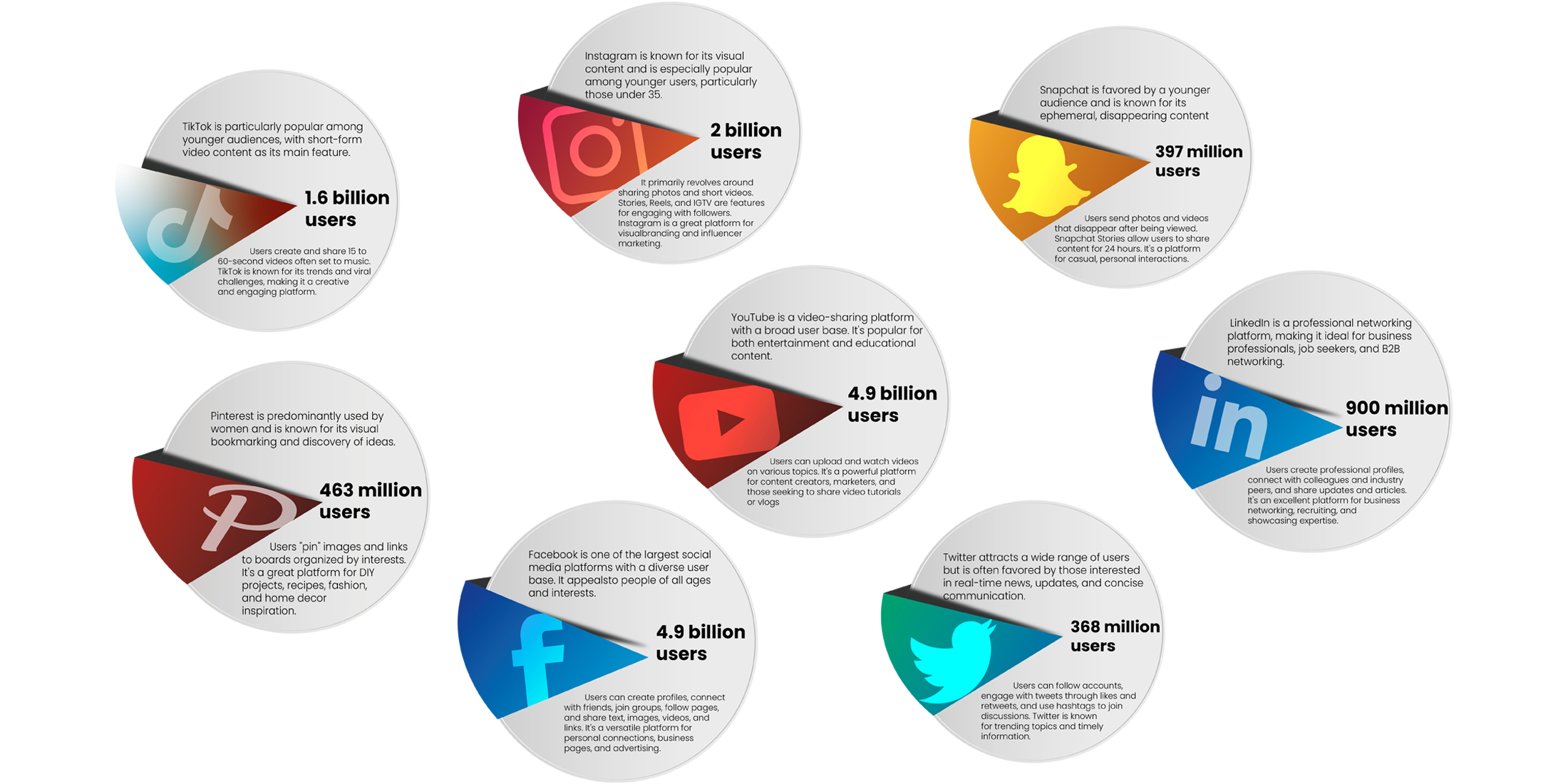
4. Social Media Strategy
Social media marketing is the process of using social media to advertise the introduction of a new product your company is releasing. Engaging with your clients through comments is a form of social media marketing. Incorporating your brand’s values and narrative into captivating content is also considered social media marketing.
A social media marketing strategy is an outline of all the things you want to accomplish and the things you want to do on social media. It directs your activities and indicates your level of success or failure.
Your plan will work better if it is more detailed. Remain succinct. Avoid making it so sweeping and high that it becomes unachievable or hard to quantify.
We’ll take you through a nine-step process in this post to help you develop a successful social media strategy of your own. Even Amanda Wood, Senior Manager of Social Marketing at Hootsuite, has contributed her expert ideas.
It is necessary to use social media management tools and talents for this type of marketing. You must plan your social media marketing strategy in the same way that you would other parts of your marketing strategy.
The components of a social media strategy typically include a content plan, a posting schedule, and audience targeting. Here’s an overview of each component:
4.1. Content Plan
The most crucial element in the effectiveness of your social media campaign is content planning. There’s much more to it than picking a picture, adding a caption, and setting a posting time. Even with the greatest social media marketing strategy in the world, it won’t work without careful planning for content.
Creating content in bulk is far more effective than attempting to think of a piece on the spur of the moment for a particular campaign or each day. When you batch write, you deliberately set aside time to create a large amount of social network content at once.
You’ll benefit more from it in addition to writing material more effectively. Take fragments of each piece of material you write and use them for other purposes.
The components of a social media strategy typically include a content plan, a posting schedule, and audience targeting. Here’s an overview of each component:

In the content plan, it’s crucial to establish clear content goals, such as increasing brand awareness, driving website traffic, generating leads, or fostering community engagement. You’ll also determine the variety of content types you’ll utilize, such as text posts, images, videos, infographics, articles, and user-generated content, ensuring diversity and engagement. To maintain consistency and alignment with your brand and target audience, identify key content themes. Additionally, create a content calendar specifying publication times and platforms for a well-organized posting schedule. Outline the content creation and sourcing process, including responsibilities, approval procedures, and required resources. Finally, define a brand voice and messaging style that remains consistent across all content to uphold a cohesive brand identity.
4.2. Posting Schedule
Keeping an active presence on social media is more smart than it might seem in the complex world of social media marketing. Due to user behaviour and algorithms, each social network has its own peak hours. Posting is not enough to engage a large audience; you also need to post strategically. Not only is it difficult to rely on real-time posts, but it is also ineffective. That’s where social media scheduling tools’ capability becomes useful. With the use of these systems, marketers like us can plan, schedule, and automatically create posts that will maximise interaction.
By using these tools, you can make sure that your material is in line with the peak activity of your audience and post more purposefully than just to simply post. Working smarter, not harder, is the goal.
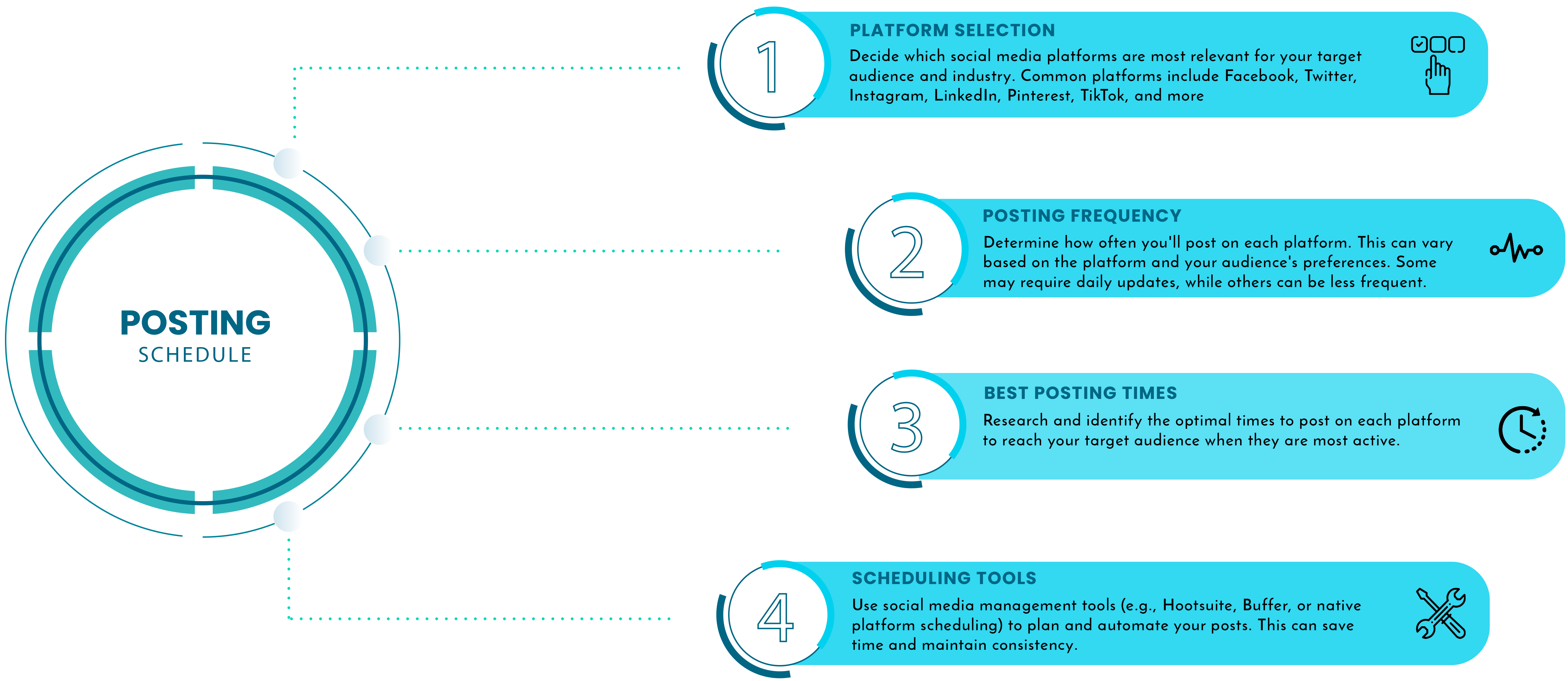
The first step in creating a successful posting schedule is deciding which social media sites are most appropriate for your industry and target audience. Sites like Facebook, Instagram, LinkedIn, Pinterest, and TikTok are just a few examples. Ascertain the frequency of posting on each platform, considering the interests of the audience and the dynamics of the platform; some may require daily updates, while others may require less regular updates. To reach your audience during their peak activity, conduct research and determine the optimal publishing hours. Use social media management tools such as Hootsuite, Buffer, or native platform scheduling to plan and schedule your posts in advance. This will help you save time and maintain consistency in your online presence.
BEST SOCIAL MEDIA SCHEDULING TOOLS
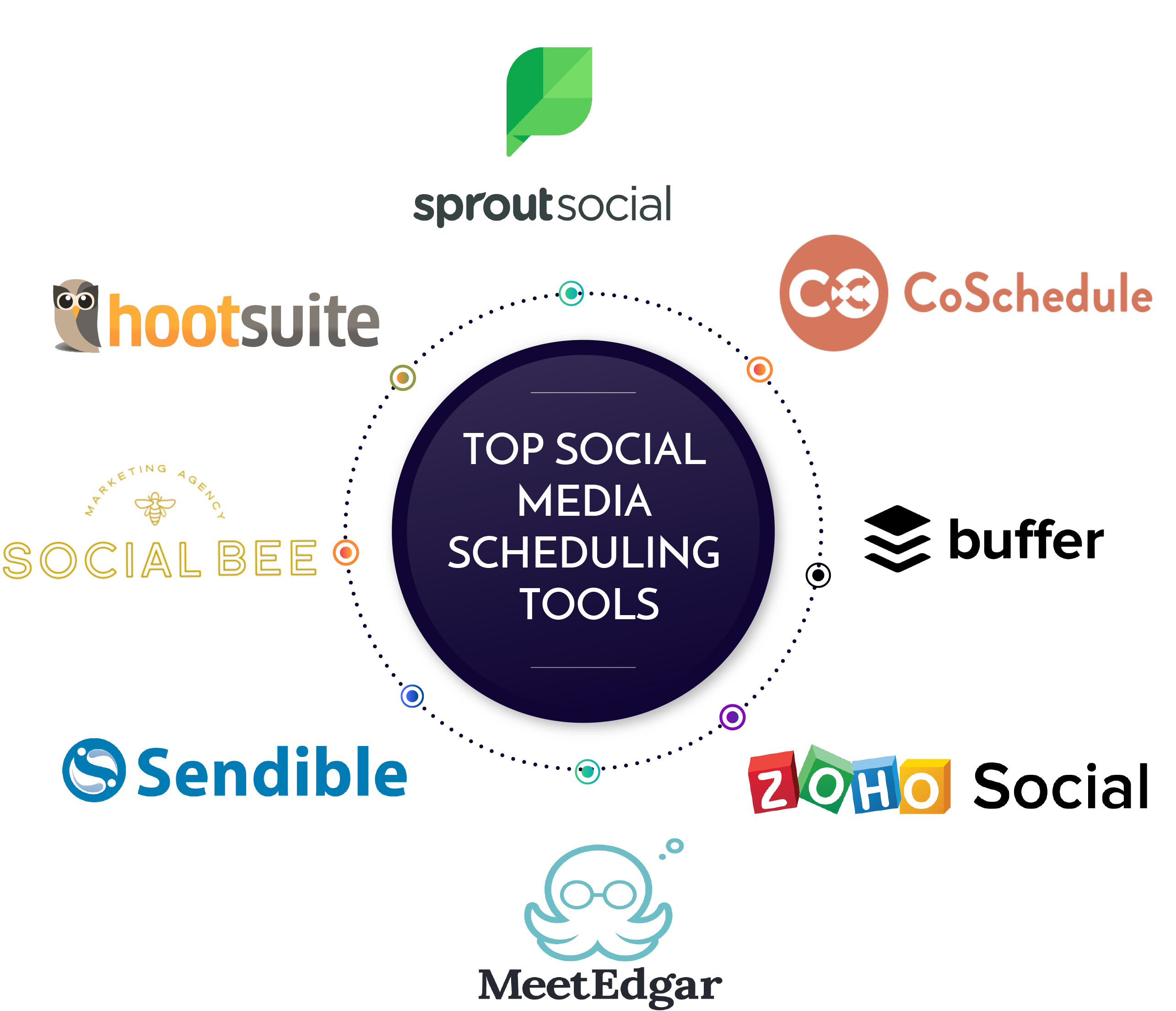

4.3. Audience Targeting
A social media target audience is a group of people that you’ve identified that you want to appeal to. This can be based on demographics such as age, job title, income level, education, location, or behavior. Your social media target audience consists of the people who are most likely to be interested in your product.
You must identify your target audience before you can “find” them. Creating a consumer persona is the first stage, thus. And I’m not simply referring to the ones that are gathering virtual dust in a Google Drive file. however, those who possess the useful data required to create effective marketing strategies. Furthermore, that extends beyond determining the fundamental audience demographics of marital status, wealth, and education. To truly gain a competitive edge.
then you must gather information on your audience, such as their:preferred social media site for information (Facebook, Twitter, )preferred reading material (subjects and styles, such as blog entries, videos, and stories) Popular subjects to talk about (people, news, events?)dependable individuals they interact with and follow (bloggers, brands, thought leaders, influencers, etc.)You may now better understand your tribe and know what kind of content to produce thanks to this insight. Your pass to creating a successful marketing strategy. here is the way for a successful targeting :

In order to guarantee a successful audience-centric strategy, begin by creating thorough audience personas that include goals, behaviours, hobbies, pain areas, and demographics to obtain a thorough grasp of your ideal clients or followers. Next, divide your audience into groups according to pertinent attributes. This will help you customise your material to each group within your target audience and cater to their particular requirements and interests. Use content personalization to provide content that appeals to these particular audiences. Strategies for interaction and engagement should be developed, including how to reply to messages and comments and actively participate in discussions that are pertinent to the sector. Finally, establish key performance indicators (KPIs) to gauge the effectiveness of your audience targeting initiatives and enable data-driven modifications and optimisation of your social media strategy. Examples of KPIs include engagement rates, click-through rates, and conversion metrics.
5. Content Creation and Curation
Social media has developed over time into a cutting-edge, unexplored technology that, as of 2021, is utilised by over 55% of the global population. You are seriously missing out on a great opportunity if you haven’t given social media content production for your business some thought. Its impact on the marketing industry is unmatched. The majority of internet marketers 73 percent agreed that using social media marketing techniques to promote their brand had been successful. Therefore, you’re missing the essential component of the puzzle high-quality content if you’re only utilising social media to monitor engagement levels and for promotional purposes.
Don’t worry if you’re new to social media or a small business hoping to take advantage of the benefits of coming online, or if you’re an experienced copywriter trying to adapt your work to various online formats. We address the most frequently asked topics regarding social media content development, including what it is and why it matters.
Content that is distributed via social media platforms or channels for people to enjoy and learn from is known as social media content creation. Among the most widely used social media platforms are YouTube, TikTok, Pinterest, LinkedIn, Instagram, Twitter, Facebook, and Snapchat.
Social media posts, infographics, photos, shared blog entries, videos, live feeds, memes, quizzes, and polls are a few examples of the various formats in which information can be created. Adding any or all of these resources to your social media accounts could be considered social media content creation.
User-generated content could also be included, which entails leveraging audience posts and interactions to support your work and brand messaging.
Here is some steps to follow in order to create a relevent content :

Understanding your audience well is the first step in producing interesting and pertinent content for social media. Create thorough audience personas first, going into great depth about your target audience’s characteristics, hobbies, habits, and preferences. You can better customise your material to their unique requirements and interests by using this core knowledge. Use analytics and data as well to learn more about the kinds of content that have historically been successful. Your content strategy can be guided by these insights, which can also help you build on the things that your audience finds engaging.
Clearly define your content’s goals. Decide if you want to inspire, motivate, educate, or amuse people. For the purpose of building a purposeful and consistent brand presence, your material should be in line with these goals.
Create a plan outlining your content themes, topics, and messaging in order to carry out your content strategy successfully. Make sure these components appeal to your audience and are consistent with your brand concept. Include text, photos, videos, infographics, user-generated content, and more to diversify your content formats. This diversity accommodates a range of tastes and consumption patterns, keeping your social feed lively and captivating.
High-quality content is essential. This entails keeping professional presentation, well-written material, and lucid graphics. Using stories in your material can help make it memorable and relatable. Tell emotionally charged stories to your audience to strengthen the connection between your brand and your followers.
Give your content’s visual component careful consideration. Make use of eye-catching images, hues, and design components to set your material apart. Posts about holidays, trends, and current events should be made when appropriate because timeliness and relevancy are crucial. Your material should benefit your readers as well, whether it is through fun blogs, practical advice, or educational publications.
Maintaining a regular posting schedule is essential to keeping your audience interested and coming back for more. Promote user-generated content to help your brand become more authentic and socially connected. Engage your audience by leaving comments, answering inquiries, and taking part in pertinent discussions.
Include calls to action (CTAs) that are obvious and engaging in your content to entice readers to take certain actions, such liking, sharing, commenting, or clicking on links. Try A/B testing to find out what kinds of material and when to post them are most effective for your target audience. Examine your social media statistics on a regular basis to see what’s effective and ineffective, and be prepared to modify your content strategy accordingly.
Keep an eye out for popular subjects and attempt to include them in your work when appropriate, as viral content can greatly expand your audience. Finally, take note of your rivals’ effective tactics and learn from them. However, constantly work to set your content apart to establish a distinctively appealing brand.
The secret to producing interesting and timely content is to satisfy your audience’s needs while maintaining the identity of your business. To keep your brand new and interesting, always modify and develop your content strategy in response to audience input and shifting trends.
6. Analytics and Performance Tracking
You select the targets and goals you want your marketing efforts to achieve when developing your social media strategy. How will you know, though, whether you’re succeeding in your objectives if you’re not keeping an eye on your social media analytics, metrics, and performance?
Proving return on investment, making wise business decisions, and much more depend on social media analytics, which are fortunately available on almost all platforms in the form of in-app analytics. Additionally, there are several social media analytics tools available to assist you in keeping an even closer eye on your performance.
The process of gathering information and metrics to assess your overall success on social media is known as social media analytics. By doing this, marketers can better understand the kinds of social media material that appeal to their target demographic and modify their approach accordingly.
Social media analytics support marketers in a variety of ways, from strategy formulation to campaign and content concept preparation. There are five main areas where social analytics tracking might be useful.
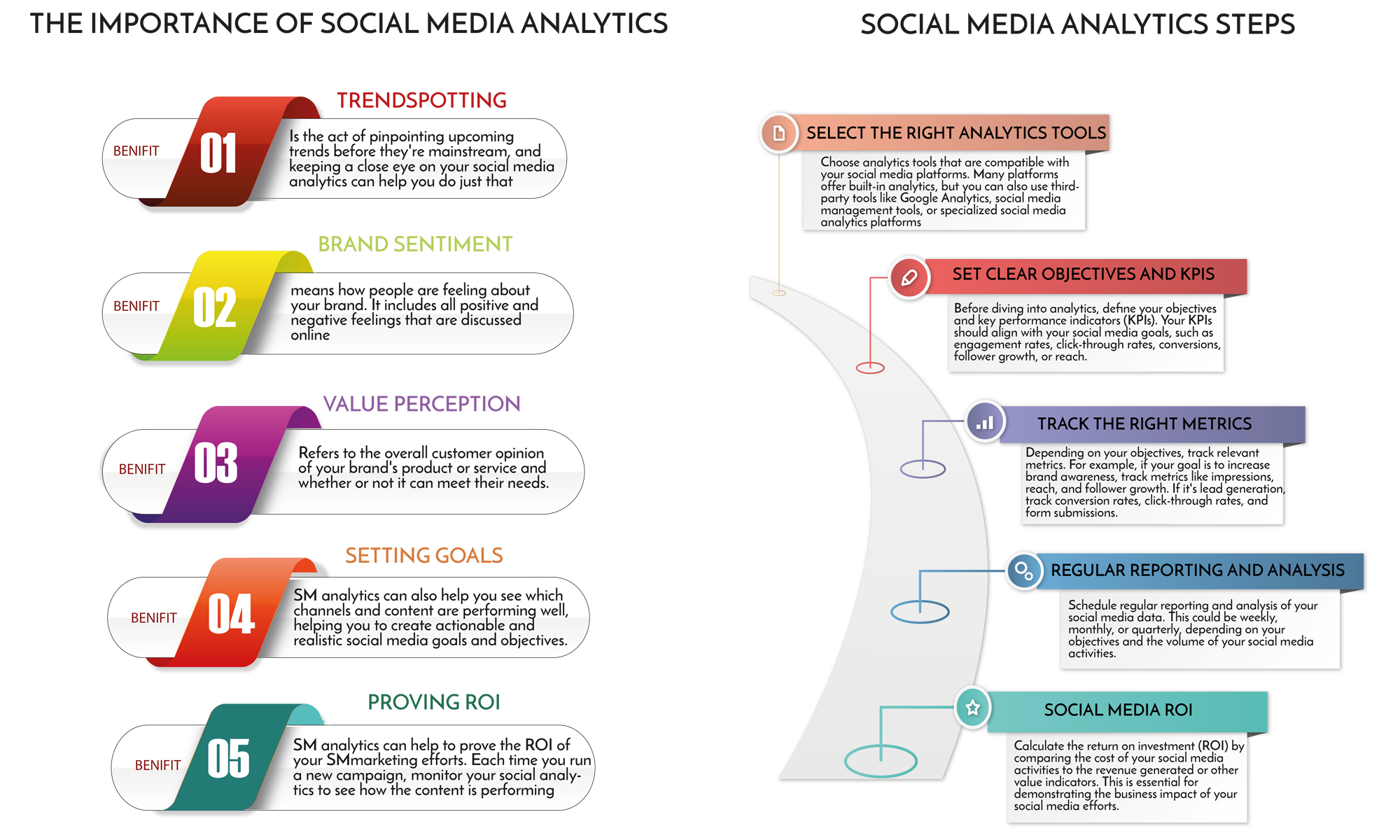
Measuring social media performance using analytics tools is a crucial step in determining how successful your social media strategy is. Here’s how to use these tools efficiently, step-by-step: Begin by choosing the appropriate analytics tools, taking into account their compatibility with the social media networks you use. Make sure your key performance indicators (KPIs) and objectives are well-defined and in line with your social media aims. Monitor any metrics—brand awareness, engagement rates, conversions, or other metrics—that are relevant to your goals. Depending on your objectives and volume of activity, regular reporting and analysis should be scheduled on a weekly, monthly, or quarterly basis. Learn about the demographics, interests, and behaviours of your audience with the help of analytics. Analyse content performance, noting postings with high levels of engagement and favoured content kinds.
Track engagement metrics, such as likes, comments, shares, and retweets, and emulate effective tactics. To determine how well your social media marketing is generating visitors and conversions, examine your click-through and conversion rates. Take part in competitive analysis to learn from the winning tactics of your rivals and set yourself apart. Determine the return on investment (ROI) to show how your social media activities have affected your business. Refine your plan using data-driven decisions, do A/B testing, pay attention to audience comments, and adjust to changing trends and algorithm adjustments. Lastly, keep careful records of analytics data over time to monitor long-term patterns and evaluate the effectiveness of your strategies. You may consistently maximise your social media efforts and accomplish your targeted results with the help of this continuing procedure.
7. Social Media Advertising
Social media advertising is a digital marketing strategy that enables you to run paid advertisements on social media platforms. This strategy involves paying to promote content on social media sites to reach interested leads and get them to check out your business. Reaching a far wider audience than your current following on social media is one of the main advantages of running a paid advertising campaign there. Additionally, not everyone sees your advertisements (unless that is what you want). Social media platforms have extensive user data, including broad demographics like age, gender, language, and geography. They are aware of the tastes and actions of their users. They even provide contact lists, phone numbers, and email addresses.
Social media advertising systems allow you to target almost anyone you want, as long as it’s within reason, using that information. By using social media advertisements, you can reach qualified audiences who are most likely to be interested in your goods and services, in addition to reaching new audiences.
Why should I use social media advertising?
Having learned the meaning of social network advertising and the platforms on which it can be found, you may be asking yourself why you should spend money on this kind of social media. These are five justifications for developing a social media marketing plan

A. Increase brand awareness
Because social media platforms have a wide audience and high levels of engagement, social media advertising is an effective way to raise brand exposure. First of all, it enables marketers to target a wide range of consumers directly by using psychographic, geographic, and demographic data. Through the creation of visually captivating and captivating advertising creatives, companies may leave a lasting impact on users as they peruse their social media feeds. Regular exposure to brand messaging and imagery contributes to top-of-mind awareness, strengthening the brand’s recall and recognition among the intended audience.
Second, social media advertising encourages audience involvement and engagement. Interactive polls, competitions, and narratives are examples of engaging content that can motivate people to get involved with the business. Users are more likely to remember a brand and its message when they interact with it. Users can also spread brand material within their networks thanks to social media’s shareability, which increases brand exposure. Social media’s viral potential allows material to spread quickly and widely by being liked, shared, remarked on, and re-shared, which naturally expands its audience. This dynamic environment contributes to the brand’s increased awareness and recognition by generating talk about it.
B. Encourage engagement
Because social media advertising is interactive and focused on the user, it is excellent at promoting engagement. First of all, these platforms give brands a direct line of communication with their target market. Polls, quizzes, and competitions are examples of interactive ad formats that encourage user participation by providing a two-way channel of communication. Users show greater interest in a brand’s message, good, or service when they actively interact with its advertisements. Increased trust, brand loyalty, and even conversions may result from this interaction.
Secondly, social media’s real-time feedback mechanisms, such as likes, comments, and shares, provide immediate gratification for users, reinforcing their connection with the brand. Engaging content and storytelling can provoke discussions, user-generated content, and viral sharing. These actions help extend the reach of the brand’s message, as user interactions are often visible to their connections. Moreover, brands can employ social listening to respond to comments, address concerns, and acknowledge positive feedback, further humanizing their online presence and building a sense of community. Overall, social media advertising’s ability to facilitate genuine, interactive connections with the audience encourages engagement and builds a stronger, more loyal customer base.
C. Target more people interested in your business
Advertising on social media is an effective way to target customers who are actually interested in your company. It provides you with a number of advanced targeting choices that let you precisely target the proper audience. First of all, you can target users according to their demographics, which include language, region, age, gender, and even particular life events. This makes it more likely that people who fit your target client profile will notice your advertisements.
Second, advanced targeting based on interests and behaviours is available on social media platforms. Your target audience can be identified by looking at their internet habits, hobbies, likes, and pages they follow. For example, if you own a brand of fitness apparel, you can market to people who are into sports, fitness, or similar activities. By doing this, you can be sure that people who are already interested in your goods or services will see your advertisements. Additionally, you may retarget past clients or website visitors who have already expressed interest in your company thanks to the option to create bespoke audiences by uploading your customer email lists or website visitor data.
D. Generate more leads
Advertising on social media is an effective way to target customers who are actually interested in your company. It provides you with a number of advanced targeting choices that let you precisely target the proper audience. First of all, you can target users according to their demographics, which include language, region, age, gender, and even particular life events. This makes it more likely that people who fit your target client profile will notice your advertisements.
Second, advanced targeting based on interests and behaviours is available on social media platforms. Your target audience can be identified by looking at their internet habits, hobbies, likes, and pages they follow. For example, if you own a brand of fitness apparel, you can market to people who are into sports, fitness, or similar activities. By doing this, you can be sure that people who are already interested in your goods or services will see your advertisements. Additionally, you may retarget past clients or website visitors who have already expressed interest in your company thanks to the option to create bespoke audiences by uploading your customer email lists or website visitor data.
E. Earn more sales
By providing a direct and interesting channel for connecting with potential customers, directing traffic to your website or online store, and nurturing leads into paying customers, social media advertising can dramatically increase revenue. In order to boost sales via social media advertising, you must create ad campaigns that are extremely relevant to your target audience in addition to being aesthetically pleasing. Establish specific goals from the outset, such as boosting sales of your products, increasing website traffic, or promoting special offers, and then adjust your ad creatives and content to meet those goals.
Furthermore, social media networks provide effective remarketing and conversion tracking capabilities. After a person clicks on one of your adverts, you can monitor what steps they take to complete a purchase or submit a contact form. Through the examination of these conversion data, you may adjust your campaigns to concentrate on the most successful tactics. You can re-engage customers who have previously expressed interest in your goods or services but did not complete a purchase by using retargeting. For example, you may display advertisements to customers who added products to their cart but abandoned it, urging them to come back to your website and finish the transaction.
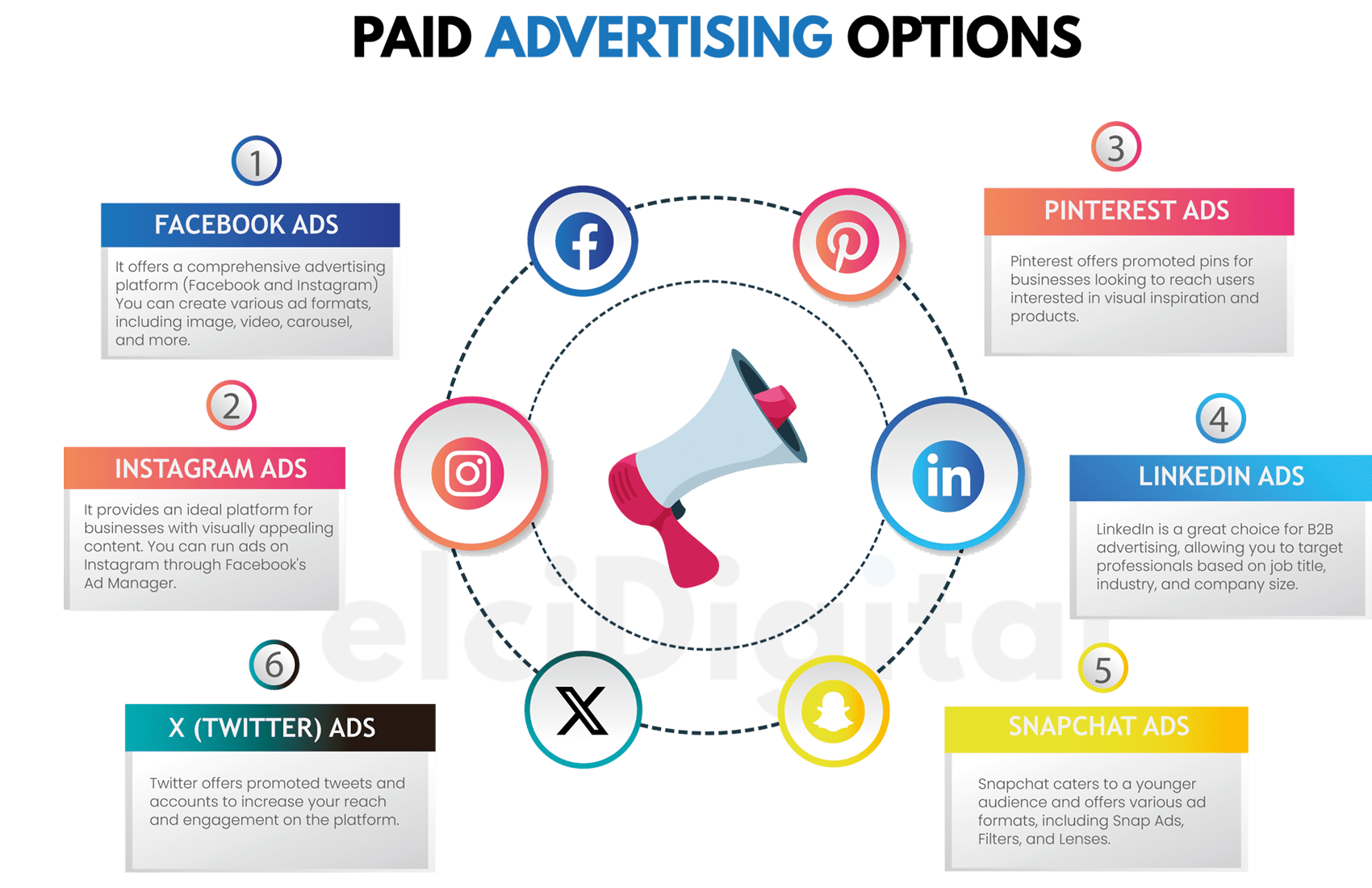
Social media networks offer a wide variety of alternatives for paid advertising, giving businesses the ability to target very particular audiences. Facebook Ads, which provides extensive ad styles for Facebook and Instagram, is one of the most well-liked platforms for social media advertising. Facebook owns Instagram Ads, which are perfect for visually stimulating content. With promoted tweets and accounts, Twitter Ads enable greater reach and interaction. LinkedIn Ads target professionals based on job title, industry, and firm size, making them ideal for B2B advertising. Users who are interested in visual inspiration and items are engaged by Pinterest Ads, which take the shape of promotional pins. With a variety of ad types including Snap Ads, Filters, and Lenses, Snapchat Ads target a younger audience.
how to create effective ad campaigns on social media ?
You must thus launch a social media marketing strategy, right? Enjoyable! We are not joking. A digital marketing campaign is one of the most immediately satisfying things to develop, execute, and watch the fruits of your labours appear.
There is, of course, a little bit more to it than that. Here, we’ll walk you through every step so you can take advantage of one of the most powerful and economical marketing campaigns any company can launch.
-
Step 1: Define Your Social Media Campaign Goals
-
Step 2: Identify the social media channels you’ll use
-
Step 3: Plan your social media campaign strategies
-
Step 4: Choose the metrics you want to monitor
-
Step 5: Create a social media content calendar
-
Step 6: Design Your Marketing Assets Using Free Online Tools
-
Step 7: Schedule Your Posts Using Content Scheduler In Adobe Express
-
Step 8: Manage Your Campaign
-
Step 9: Analyze the Results
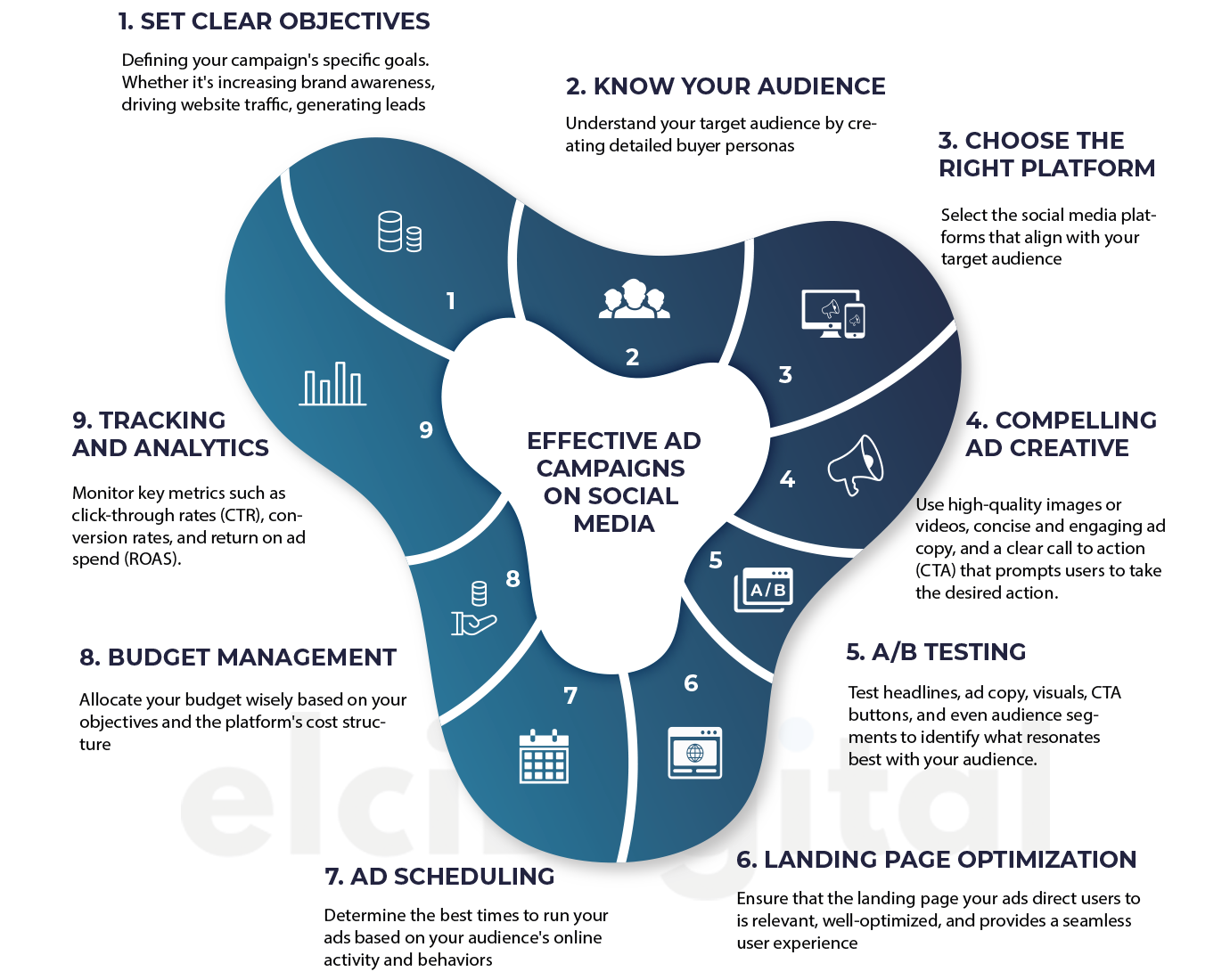
Creating effective ad campaigns on social media involves setting clear objectives, understanding your target audience, choosing the right platforms, designing compelling ad creatives, A/B testing for optimization, ensuring landing page relevance and user experience, strategically scheduling ads, managing budgets, tracking performance with analytics tools, continuously optimizing based on data-driven insights, complying with platform guidelines and privacy regulations, staying current with platform changes and trends, and adhering to best practices. This comprehensive approach ensures that your social media ad campaigns are well-targeted, engaging, and capable of achieving your specific marketing goals.
EXAMPLES OF SUCCESSFUL SOCIAL MEDIA MANAGEMENT CAMPAIGNS.
DOVE’S “REAL BEAUTY” CAMPAIGN
Dove’s “Real Beauty” campaign promotes a positive body image for women and challenges conventional beauty standards, creating a powerful social media movement. Their “Real Beauty Sketches” video became one of the most-watched online advertisements of all time, demonstrating how authenticity and a meaningful message can resonate with the audience.
The campaign was launched by Dove in 2004. According to a global report by Etcoff, Orbach, Scott & D’Agostino, only 2% of women all around the globe consider and describe themselves them as beautiful. The campaign aimed at spreading the message that each woman is unique and beautiful in their own way and they should celebrate this uniqueness instead of ignoring, the anxiety should be transformed to confidence. The campaign delivered this message through different communication platforms like TV, magazine, talk shows, social media pages, brand’s website and a worldwide conversation i.e. electronic word-of-mouth.


WENDY’S TWITTER ROASTS
Wendy’s, a fast-food chain, became known for its witty and humorous Twitter roasts. They engage with followers and even take jabs at competitors, such as McDonald’s and Burger King. This playful and unique social media approach has generated a significant following, media attention, and a strong brand identity, ultimately boosting customer engagement and brand loyalty.
Innovation can take many forms, and Wendy’s can use it to elevate its Twitter strategy above the competition. For years, Wendy’s has taken pride in being unique, serving square patties and Frosties in place of milkshakes. Another thing that sets it apart is its Twitter strategy. Wendy’s has gained notoriety on the internet for its ability to ridicule rival businesses, make fun of both friends and foes, and provide free food to worthy patrons.
In social to be entertained. That’s the commitment we have to deliver on” says Carl Loredo, Wendy’s Chief Marketing Officer. “Twitter might be the way you talk to your brother, but as you think of Facebook it might be the way you talk to your mom … so there’s aspects of how far you go down the line,” Loredo says. “We have to be mindful of where are we, what’s the platform. Our voice on Twitter would not work in the world of Instagram.”
RED BULL’S EXTREME SPORTS AND LIFESTYLE CONTENT
The main focuses of Red Bull’s social media strategy are adventure and extreme sports content. Red Bull has established a strong relationship between its brand with the pursuit of an active and adventurous lifestyle through its regular sharing of visually attractive and thrilling films and photographs on social media sites such as Facebook, Instagram, and YouTube. This tactic has raised sales and engagement in addition to fostering brand loyalty.
Red Bull has sponsored and participated in more than 500 extreme adventure sports over the years, securing a distinctive and differentiating brand reputation as an enabler of adventure and sports events. Global sports fans were the target audience for their strategy.
Red Bull Media House, which distributes sports, cultural, and lifestyle content directly to customers or through partnerships, was launched by the brand to bolster its content strategy.
What made the brand successful? a blend of promotion and marketing strategies. Initially, the brand indirectly promoted itself by endorsing extreme activities. Second, it released excellent sports material on several platforms. Third, it had incredible publicity gimmicks. The brand’s current domination in the market is a result of all of this.

